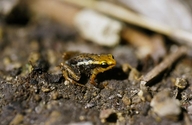|
Description
This species is a member of the Eleutherodactylus limbatus group (subgenus Euhyas). It has a light brown dorsum with black or dark brown spots concentrated in the posterior area. A small dark spot marks the middle of dorsum just in front of the line of insertion of the forelimbs, which are preceded by two smaller spots. There are two broad, white dorsolateral stripes that each extend to one of the thighs and converge at the middle of the body. These lines are outlined with black at their inner edges, except anteriorly. The head is pale yellow and lacks the dorsolateral stripes. The flanks are black and the forelimbs are orange. The venter is pale yellow. The glandular areas are absent. There is no webbing between the toes. The digits are small and the digital tips are not expanded. Finger I is shorter than finger II. The vomerine teeth are absent. Adult size is very small, averaging 13.3 mm in females and 12.5 mm in males (Barbour and Shreve 1937; Schwartz and Henderson 1991; Estrada and Hedges 1996; Rodriguez and Alonso 2003). Distribution and Habitat
Country distribution from AmphibiaWeb's database: Cuba
Eleutherodactylus orientalis is endemic to Cuba. It is known only from isolated localities in the Sagua-Baracoa Mountains, Oriente Province, Eastern Cuba, at elevations between 100 and 565 m above sea level. It is a terrestrial frog, often found under leaf litter in hardwood forests of limestone soil, and sometimes on coffee and cacao plantations. (Barbour and Shreve 1937; Estrada and Hedges 1996; Fong and Navarro 2001; Rodriguez and Alonso 2003).Life History, Abundance, Activity, and Special Behaviors
This species, along with another miniaturized Cuban species, E. iberia, is one of only two eleutherodactylid species known to be toxic. It sequesters lipid-soluble alkaloids (pumiliotoxins) in the skin, probably from dietary sources; analysis of stomach contents from three individuals revealed a high percentage of mites (66%), with oribatid mites being most prevalent. Trace amounts of the pumiiotoxin 267C were found in ethanol-preserved skins of E. orientalis individuals collected in October 2009, but not in methanol-preserved skins collected in January 2010. This is in contrast to E. iberia specimens, which were found to contain trace amounts of a different pumiliotoxin (PTX 323A) in ethanol-preserved skins from 2009 but significant amounts of PTX 323A in methanol-preserved skins from 2010, as well as other pumiliotoxins and indolizidines (Rodríguez et al. 2010).
Males vocalize from the ground. Calls consist of a series of irregular, high-pitched “chirps” with the dominant frequency around 6.6 kHz (Estrada and Hedges 1996). E. orientalis is thought to breed by direct development (Stuart et al. 2008).
Trends and Threats
This species is considered Critically Endangered due to its very restricted range. It generally requires pristine forest. Habitat degradation and loss due to agriculture and tourism present the main threats. Although it occurs within a nominally protected area, El Yunque de Baracoa Ecological Reserve, this area would benefit from improved protection. It is moderately common where suitable habitat is found (Stuart et al. 2008). Possible reasons for amphibian decline General habitat alteration and loss
Comments
Etymology- The name presumably refers to the distribution area of the species (Oriente province in Cuba).
Synonyms- Sminthillus limbatus orientalis (Barbour and Shreve 1937).
Related species- E. limbatus, E. jaumei, E. iberia, E. cubanus.
References
Barbour, T., and Shreve, B. (1937). “Novitates Cubanae.” Bulletin of the Museum of Comparative Zoology, 80(9), 377-387.
Estrada, A. R., and Hedges, S.B. (1996). ''At the lower size limit in tetrapods: a new diminutive frog from Cuba (Leptodactylidae: Eleutherodactylus).'' Copeia, 1996(4), 853-859.
Fong, A., and Navarro, N. (2001). ''Checklist of amphibians and reptiles of the Sagua-Baracoa Mountains, Eastern Cuba.'' Smithsonian Herpetological Information Service, 130, 1-13.
Rodríguez, A., Poth, D., Schulz, S., and Vences, M. (2010). ''Discovery of skin alkaloids in a miniaturized eleutherodactylid frog from Cuba.'' Biology Letters, published online 3 November 2010 ahead of print, doi: 10.1098/rsbl.2010.0844.
Rodríguez, A., and Alonso, R. (2003). ''Ranas diminutas.'' Anfibios y reptiles de Cuba. L. Rodriguez, eds., UPC Print, Vassa, Finlandia, 50-55.
Schwartz, A. and Henderson, R. W. (1991). Amphibians and Reptiles of the West Indies: Descriptions, Distributions and Natural History. University Press of Florida, Florida.
Stuart, S., Hoffmann, M., Chanson, J., Cox, N., Berridge, R., Ramani, P., Young, B. (eds) (2008). Threatened Amphibians of the World. Lynx Edicions, IUCN, and Conservation International, Barcelona, Spain; Gland, Switzerland; and Arlington, Virginia, USA.
Originally submitted by: Ansel Fong G. (first posted 2004-12-08)
Edited by: Anisha Gandhi, Kellie Whittaker (2010-11-29)Species Account Citation: AmphibiaWeb 2010 Eleutherodactylus orientalis: Baracoa Dwarf Frog <https://amphibiaweb.org/species/3100> University of California, Berkeley, CA, USA. Accessed Feb 4, 2025.
Feedback or comments about this page.
Citation: AmphibiaWeb. 2025. <https://amphibiaweb.org> University of California, Berkeley, CA, USA. Accessed 4 Feb 2025.
AmphibiaWeb's policy on data use.
|
